- Pauline Boty at Gazelli Art House.
Royal College of Art graduate Pauline Boty (1938-1966) was celebrated for her artistic talent and her beauty, and lived a short but accomplished life that ended in tragedy when she died of cancer at the young age of 28. Boty was a prominent figure in the British Pop Art movement of the 1960s. She broke with convention with her fearless exploration of femininity, societal norms, politics, and popular culture. Gazelli Art House is celebrating the life and legacy of the trailblazing British painter in Pauline Boty: A Portrait, Boty’s first posthumous solo exhibition in a decade. Looking back at her oeuvre of work in retrospect, she was a pioneer of Pop Art who would have given Peter Blake a run for his money had she lived long enough to continue with her artistic practice.

Pauline Boty, Colour Her Gone, 1962. Courtesy Wolverhampton Art Gallery. Image credit: Gazelli Art House
The exhibition features a curated selection of Boty’s paintings as well as important archival materials. This is the artist’s 3rd showing at Gazelli, and continues the gallery’s explorations of Boty’s pivotal and enduring artistic impact as her oeuvre is finally reappraised and celebrated by the art world. According to the gallery “Boty’s artworks are today venerated as climacteric within the cultural discourse surrounding the period”.
Pauline Boty ‘A Portrait’ is at Gazelli Art House until 24th February 2024: https://gazelliarthouse.com
2. Paola Orlowski at Pace.

Paola Orlowski at Pace. Photo by Lee Sharrock
‘Squelchy Garden Mules and Mamunas’ is the multi-disciplinary Polish artist Paola Orlowski’s debut solo exhibition with Pace, and features vast canvases populated by magical woodland nymph creatures, accompanied by video and installation, combining to create a folkloric world in a nostalgic land of the past. Mad Max meets Babushka in Orlowski’s bucolic universe of human-animal hybrids.

Paola Orlowski at Pace. Photo by Lee Sharrock
Born in 1976 in Gdansk, Poland, Paulina Olowska lives and works in Rabka-Zdrój and Krakow, Poland. She has exhibited at the Kunsthalle Basel; Stedelijk Museum, Amsterdam; the Zacheta National Gallery of Art, Warsaw, and stage performances at Tate Modern, Carnegie International, and the Museum of Modern Art in New York. She received the prestigious Aachen Art Prize in 2014, with an associated exhibition at the Ludwig Forum for International Art, Aachen, Germany.
https://www.pacegallery.com/galleries/london/
@pacegallery
3. Impressionists on Paper: Degas to Toulouse-Lautrec at the Royal Academy of Arts
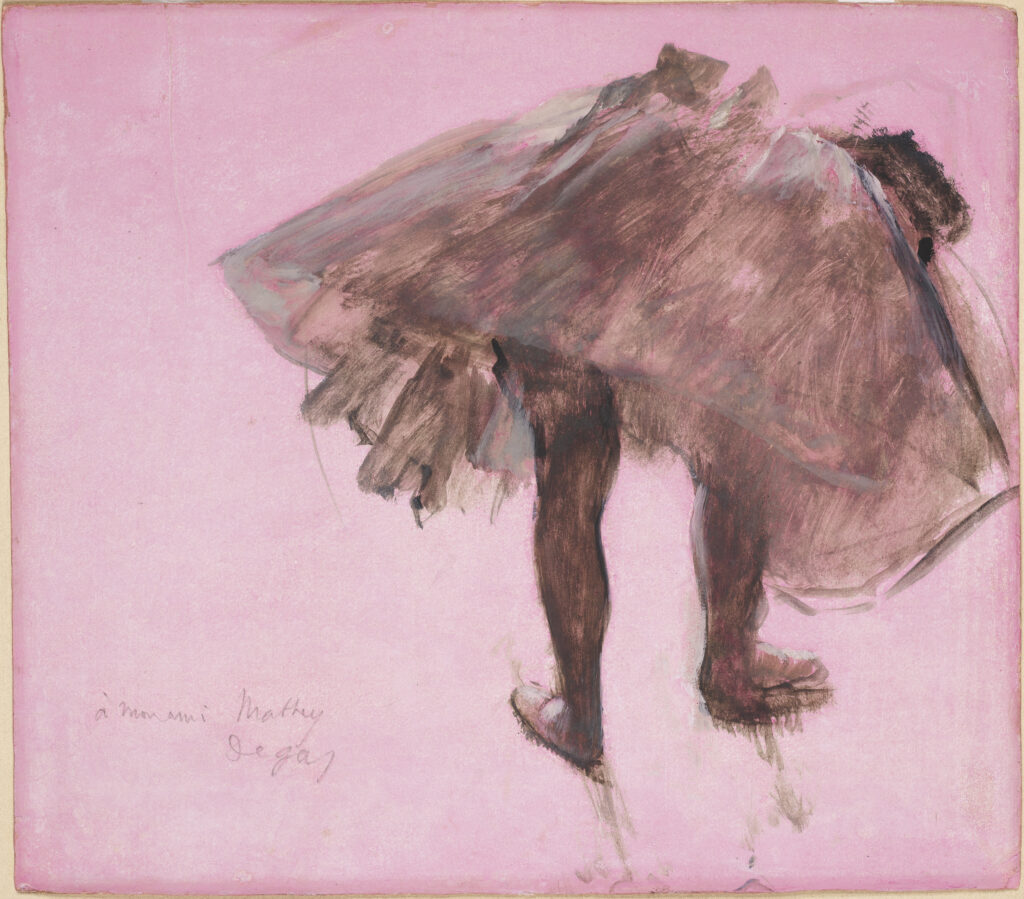
Edgar Degas, Dancer Seen from Behind, c. 1873. Essence (diluted oil paint) on prepared pink paper, 28.4 x 32 cm. Collection of David Lachenmann
In contrast to the headline-making retrospective of radical performance artist Marina Abramovic, which opened this autumn in the main galleries of the hallowed Royal Academy of Arts, the new ‘Impressionists on Paper’ exhibition is a far more serene and contemplative experience. Featuring around 80 rarely seen works on paper by some of the leading Impressionist and Post-Impressionist artists, the exhibition offers a new perspective on the familiar ballerinas, landscapes and mise-en-scène by familiar names including Cassatt, Cézanne, Degas, Manet, Morisot, Redon, Seurat, Toulouse-Lautrec and Van Gogh. Drawings, pastels, watercolours, temperas and gouaches demonstrate the range of works on paper, and elevate them from preparatory sketches to standalone artworks. The exhibition also explains technical innovations during the period which enabled the artists to create works on paper with different medium, such as new pastels, colours and crayons. ‘Impressionists on Paper’ is curated by Ann Dumas, Curator, the Royal Academy of Arts, and Christopher Lloyd, author and former Surveyor of The Queen’s Pictures.
Some Impressionist and Post-Impressionist artworks, such as Degas’ Ballerinas and Van Gogh’s Sunflowers, have been reproduced so often that they’ve been absorbed into popular culture, and we forget how innovative the style was when these artists were practicing in late 19th-century France. Their radical application of paint, use of light and unique subject matter transformed art and paved the way for later movements such as Cubism and Abstract Expressionism.
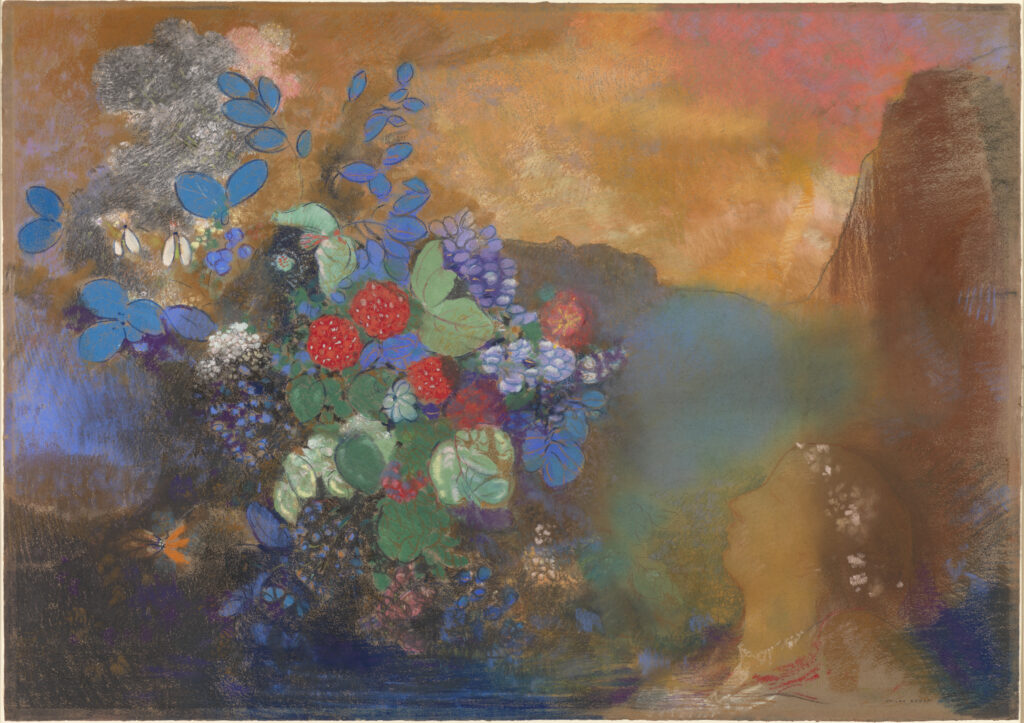
Odilon Redon, Ophelia Among the Flowers, c. 1905-08. Pastel, 64 x 91 cm, The National Gallery, London. Bought with a contribution from the Art Fund, 1977. Photo: © The National Gallery, London
The avant-garde artists known as the Impressionists came to prominence during the late 1860s and early 1870s, first exhibiting in Paris as a group in 1874. They shared a concern to depict scenes from everyday life and to address contemporary issues, which encouraged them to challenge traditional attitudes to drawing and seek innovation. Vivid colour, a quick, loose touch, and daring viewpoints, together with a deliberate lack of finish, were their means of capturing the fugitive effects of nature as well as vignettes of modern life.
‘Impressionists on Paper: Degas to Toulouse-Lautrec’ is at the Royal Academy of Arts until 10 March 2024: https://www.royalacademy.org.uk/exhibition/impressionists-on-paper
4. Winston Branch at Varvara Roza Galleries
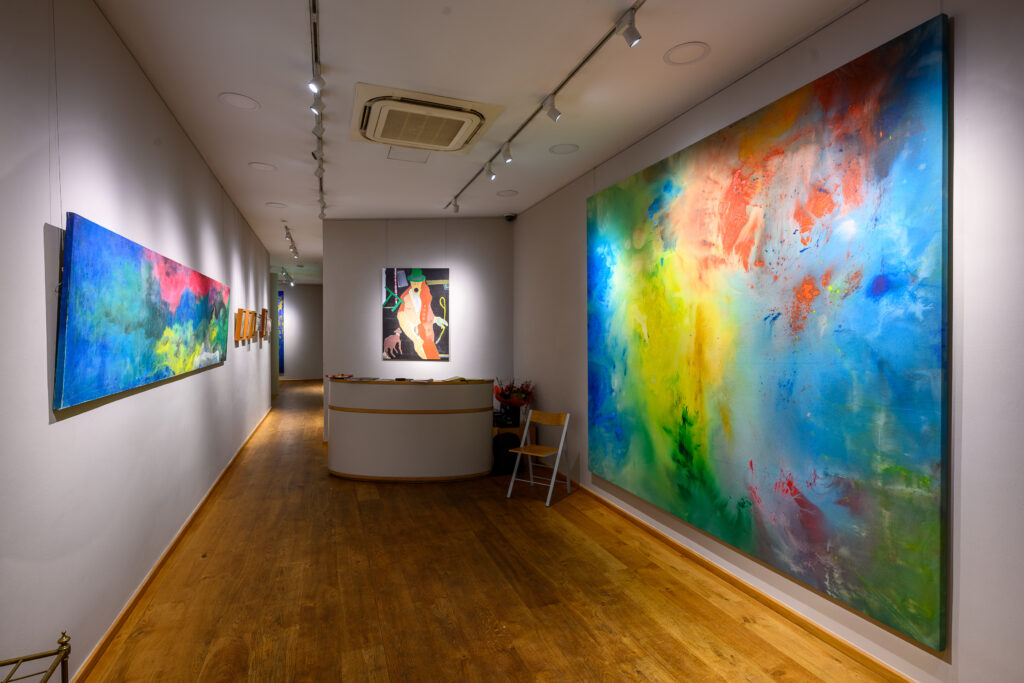
Winston Branch installation view. Courtesy Varvara Roza Galleries
Varvara Roza Galleries is presenting a solo exhibition of acclaimed British Post-war and contemporary artist Winston Branch. ‘The sweet scent of magnolia’ includes several vast new canvases painted in the artist’s London studio during a prolific period in 2023.
Branch’s abstract paintings are noted for their mesmerizing and highly emotive surfaces, conjured from the interplay of bright colours that form an entangled web of rich pigment characterized as ‘bewitching canvases’, as his abstract paintings have a bewitching intensity drawn from the subconscious.
His preoccupation as an artist has been the re-examination of finding a more palatable means of expression. The excitement with which his paintings have developed over the years, has always been to explore the magic of paint: The way a total amorphous substance is transformed into an illusionary subject. It is the sensuality of the pigment of the paint that has captivated his inner voice.
At the age of 76, Branch shows no signs of slowing down, and remains as dedicated as ever to his craft. In 2018, the Tate Collection acquired ‘Zachary II’ (1982), a stunning abstract work with a powdery blue and sandy pink palette, which the Tate compared to a Monet. ‘Zachary II’, is part of a series of eight paintings Branch made when he was living in London in the early 1980s, another of which, ‘The Magic is in You’ (1982-84) was sold in 20th/21st Century London Evening Sale at Christie’s on 13 October 2023 for £240.000.00, more than twice its estimate.
Winston Branch is a prominent British artist originally from Saint Lucia. In the 1960’s, at the age of 12, was sent to London where he studied at the Slade School of Fine Arts UCL. Branch was the recipient of a Guggenheim Fellowship, The Berlin Artist programme in Berlin (DAAD),a fellowship in Belize from Organization of American States and was Artist in Residence at Fisk University in Tennessee. He received an Honorary Doctorate from the University of Greenwich, London.
Winston Branch “The Sweet Scent of Magnolia”is at Varvara Roza GalleriesGallery 8, 8 Duke Street, St. James’s, London SW1Y 6BN until December 19th 2023: https://varvararozagalleries.com
5. Ithaca at Herald St | Museum St
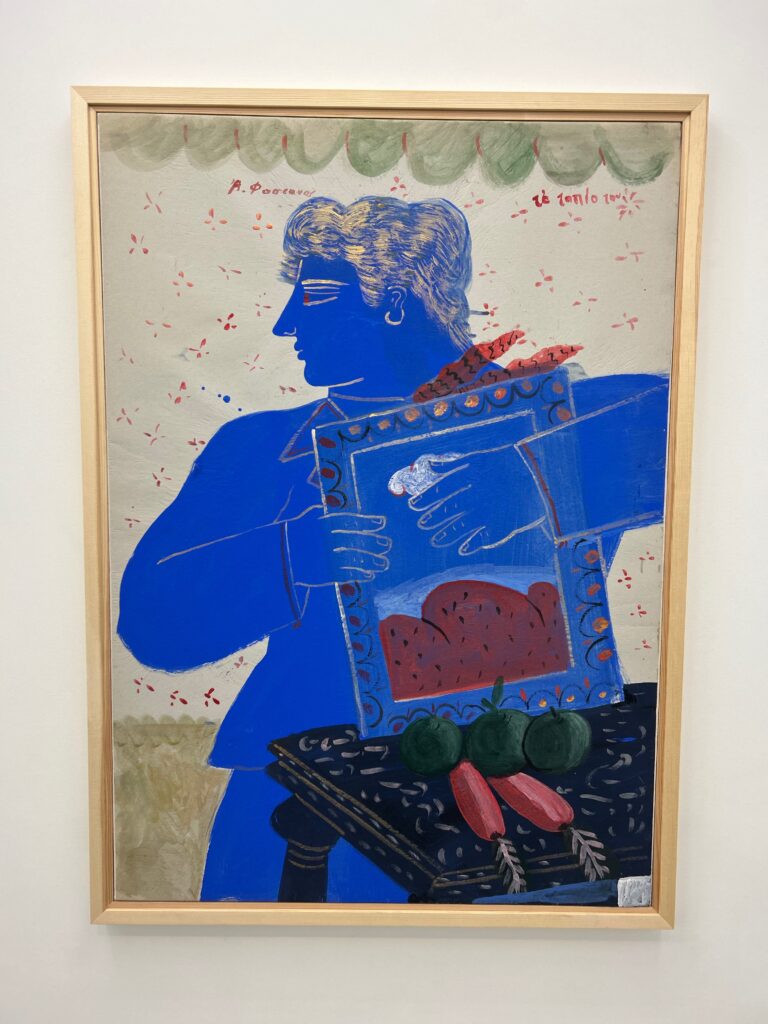
Ithaca at Herald Street Gallery. Photo by Lee Sharrock.
This eclectic group show at the gallery’s Museum Street outpost features painting and photography by Christopher Aque, Alekos Fassianos, Luigi Ghirri, Jessie Stevenson, and George Tourkovasilis. Named after C. P. Cavafy’s 1911 poem ‘Ithaca’, an emotive verse themed around myths, journeys and homecomings, the exhibition features international artists from mid-20th century to contemporary.
As you set out bound for Ithaca,
hope that the journey is a long one,
full of adventures, full of learning.
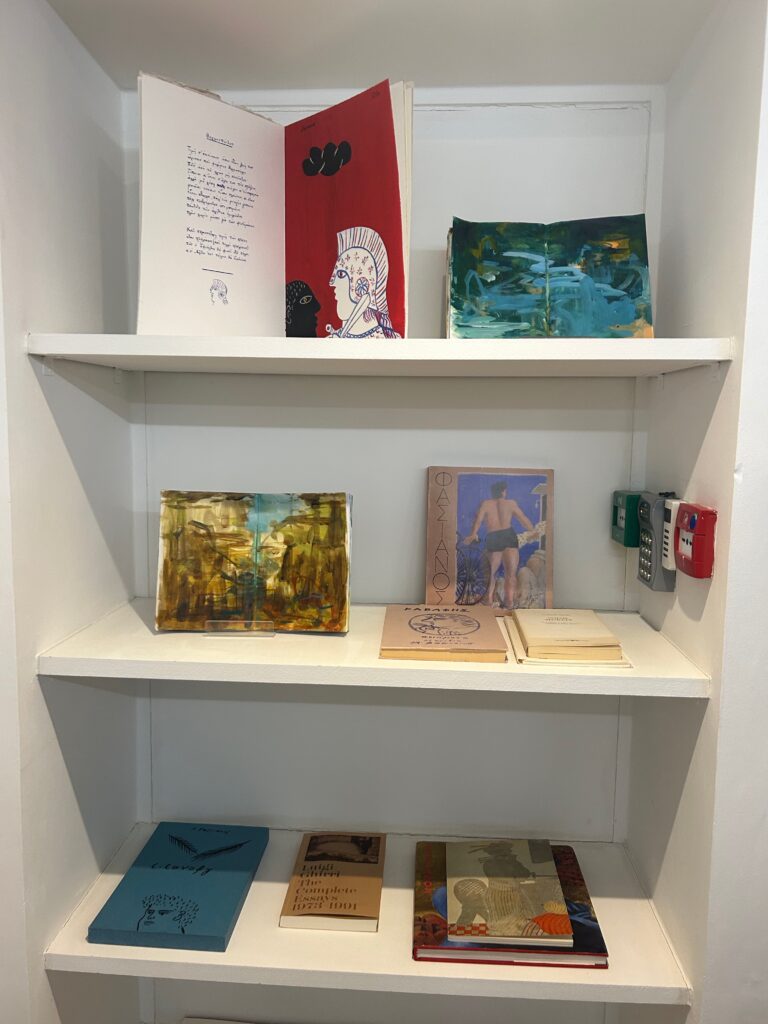
Ithaca at Herald Street Gallery. Photo by Lee Sharrock.
Cavafy’s presence in modern Greece cannot be overstated, and his influence is palpable in a number of paintings on canvas and paper by Alekos Fassianos. In his vibrant and multifaceted output, the artist mythologised the quotidian, taking the ancients gods and Byzantine icons of his childhood and imbuing café goers, cyclists, and flaneurs with the same reverence. Fassianos lived in Paris for a period of time from the 1960s and travelled extensively, yet Athens always remained close in his mind.The Dreamer is a prevalant theme running through Fassianos’s work, with memories of homelands floating behind gazing faces and bodies. Throughout his career he illustrated multiple publications authored by Cavafy, including French and Italian translations on display in the exhibition.
‘Ithaca’ is at Herald Street Gallery, 43 Museum St, London, WC1A 1LY until 27th January 2024: http://www.heraldst.com
6. Sheila Hicks at Alison Jacques
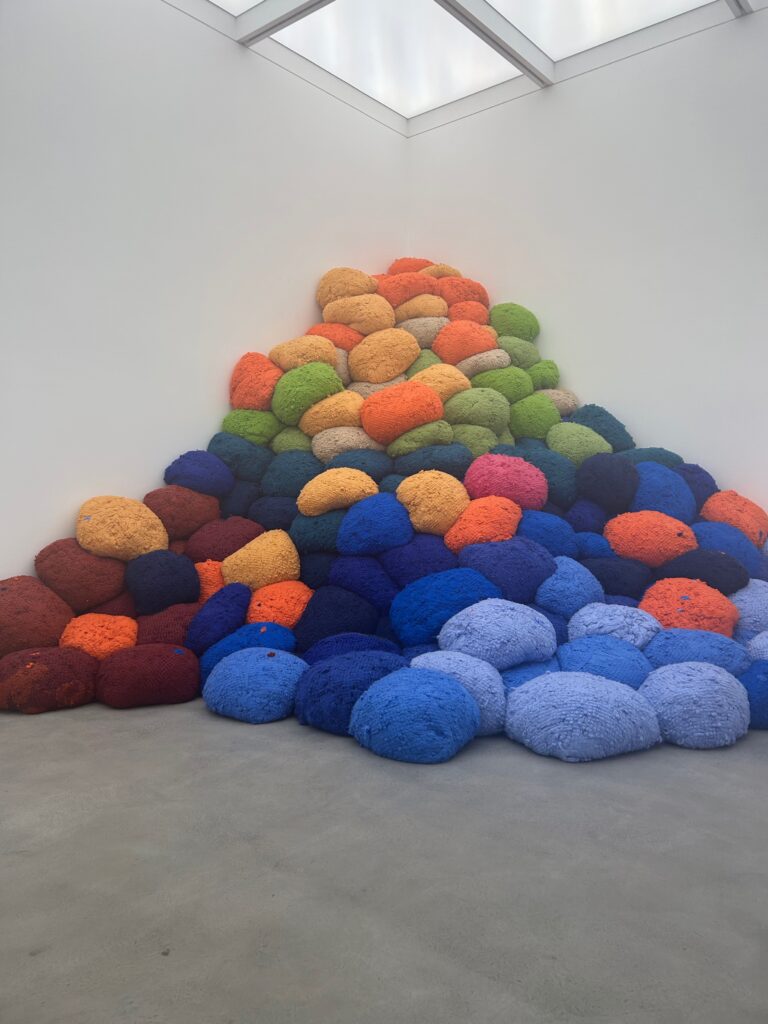
Sheila Hicks at Alison Jacques. Photo by Lee Sharrock
A vibrant selection of sculptures and installation by Sheila Hicks breathes life into Alison Jacques Gallery’s minimal white gallery on Cork Street in Mayfair. The 6,000 sq ft headquarters opened this autumn as an extension of the original gallery on Berners Street. A highlight of the solo exhibition Sheila Hicks ‘Infinite Potential’, is a new installation that lends the exhibition it’s title: ‘Infinite Potential’ consists of a vast construction of rainbow coloured textile orbs, piled up in the corner of the gallery, and difficult to resist jumping upon. ‘Infinite Potential’ is a welcome escape from the heaviness of current world events, a life-affirming celebration of colour and the hand-made featuring bas-reliefs, sculptures and installations that indulge in material tactility and the collective experience of space.
Writing in 1973, Monique Lévi-Strauss described Sheila Hicks’s (b. Hastings, Nebraska, 1934) life as ‘a tissue of threads woven together on purpose or through chance, fertile encounters.’ While decades have passed since Lévi-Strauss offered this overview, her words remain continually relevant. Since the 1970s, Hicks has established herself as one of the most distinctive artists of her generation. Working to manoeuvre colour, texture and form, the Paris-based artist has produced a rich and complex body of large-scale bas-reliefs, sculptures and installations that indulge in material tactility and the collective experience of space.
Hicks was born in Hastings, Nebraska, in 1934, but she was nomadic from an early age: growing up in the Midwest during the Depression, her father spent much of his time on the road. Hicks studied painting with Josef Albers at Yale School of Art between 1954–59, while attending art historian George Kubler’s class on pre-Columbian art and archaeology.
It was while writing a paper on ancient Andean Textiles for Kubler’s class that Hicks taught herself to weave on a backstrap loom of tree branches and assemble threads on a small frame made of painting stretchers. (To this day, she uses painting stretchers to create intimate works, which she refers to as minimes.) In 1957, Hicks was awarded a Fulbright Scholarship, which enabled her to travel extensively around South America, methodically documenting and photographing. She lived and worked in Guerrero, Mexico, from 1959 to 1964. Hicks is at her most recognisable when producing monumental hangings, tapestries, bas-reliefs and sculptures: The Questioning Column (2016), first installed at the entrance of the 2016 Sydney Biennale, rose to over 7 metres; Escalade Beyond Chromatic Lands, presented at the 2017 Venice Biennale, saw an avalanche of synthetic, brilliantly colored bales piled up to the ceiling of the Arsenale.
Sheila Hicks ‘Infinite Potential’ is at Alison Jacques, Cork Street, London: https://alisonjacques.com/artists/sheila-hicks



